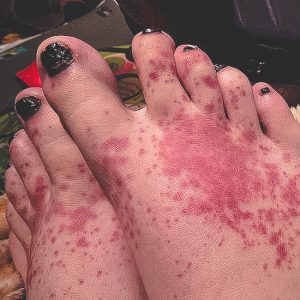 In dermatology terms, hives are called “urticaria.” They are welts that form on the skin in a number of different sizes, from small dots to larger ones.
In dermatology terms, hives are called “urticaria.” They are welts that form on the skin in a number of different sizes, from small dots to larger ones.
The amount of skin that hives can cover also varies, depending on the severity of your case.
In some cases, hives can clear up within 24 hours, while in others they can last for up to six weeks. This longer form of them is known as acute hives.
WHO GETS HIVES?
Hives often are caused by an allergic reaction, and anyone can get them whether or not they have known allergies. They often occur on people who have allergies or sensitivities to medications, fragrances or dyes, certain foods, insects, pollen and molds. According to dermatologists, around 20 percent of people will have at least one case of hives in their lifetime.
Other causes of hives include stress, sun exposure, excessive skin scratching, certain chemicals, alcohol, over-exercise, and exposure to extreme temperatures, such as heat and cold. Some illnesses, like colds and the flu can also cause hives.
WHAT ARE THE SYMPTOMS OF HIVES?
Hives appear as raised bumps on the skin’s surface. They can be red or pink, and form patches in the affected areas. They also itch, and can cause those areas of your skin to feel hot to the touch. Hives can also cause swelling. In extreme cases, depending on the allergen that you were exposed to, your eyelids and mouth can swell, and this can lead to trouble seeing, swallowing or breathing. In these extreme cases, you should medical help immediately.
HOW CAN HIVES BE TREATED?
A dermatologist or doctor can prescribe antihistamines to alleviate the main cause of the problem. There are also several topical medications that can help, including cortisones and those that fight inflammation. Once the current case of hives has been dealt with, the next step involves getting an allergy test or blood test to determine what you are allergic to. This can prevent the hives from reoccurring after additional exposure.
